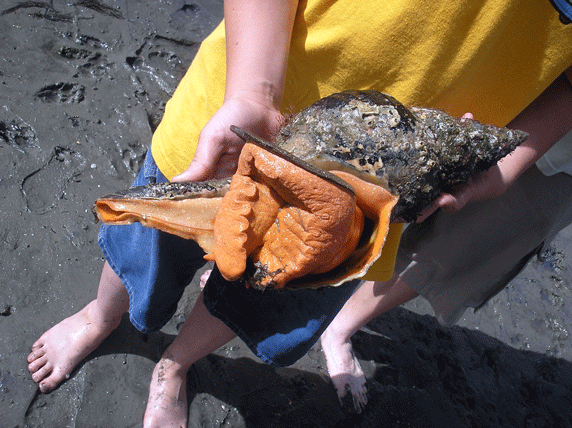|
Data:
My son found this live shell last week at the lowest tide in 4 years
on the intracoastal waterway at Wrightsville Beach, NC. We didn't peel
off the periostracum but it looks a little beige under some spots. We
think it's a true tulip. Do you agree? It's at least 14 inches long
so that's way larger than anything I could find in the literature. Must
be a real oldy ! We put him back in his muddy, dark spot where I'm sure
the tide covered him before someone else found him. What an amazing
beast !
If we ever find
one again, (Ha!) is it okay to take off the outer layer to see the shell?
Or does that harm the snail in any way, other than to make it more visible
to predators? Thanks a bunch. It'll be fun to get responses.
Nancy
Send
Ideas to:
Nancy
|
|
Identified:
Discussions:
-
Nice find. I'm quite envious. It's been a very long time since
I have been able to stroll along a beach to find anything! :-((
What your son may have picked up is a Horse Conch (Pleuroploca gigantea
- Kiener, LC, 1840). However, it does not seem to have any ridges
showing in the picture you have sent. Also NC is a bit north in
it's natural range.
See:http://www.seashells.org/seashells/horseconch.htm
http://www.gastropods.com/1/Shell_3331.html
From what I can find out, True tulip shells ( Fasciolaria
tulipa - Linnaeus, C., 1758) only attain a length of up to 9.8".
Now, that is not to say that your son may have indeed found a very
large, old Fascioloaridae tulipa....See: http://www.whitney.ufl.edu/species/tulip.htm
http://www.gastropods.com/0/Shell_940.html
...Avril
-
I agree with a previous responder that this is a rather smooth
specimen of Pleuroploca gigantea. It is not outside of its "normal
range" as it is found in embayment environments here less than
100 miles south of Wrightsville Beach. ...Dick
-
You definitely found a Horse Conch. 14" is a fair sized
one for NC--although they grow much larger in Florida. A key to
the ID is the knobbed whorls on the apex. A tulip shell is totally
smooth. The animal color is a true giveaway for me, though--orange!
Most people would probably tell you not to scrape the periostracum
away, but you can in a small area. I'm not sure that would help
with the shell you found, though. They are so encrusted (always)
that it's very hard to get down to the shell itself without a great
deal of work. I would think the areas on the siphonal canal would
be more easily scraped of periostracum and have a greater chance
of being "repaired" by the animal than anywhere else on
the shell.
I have found many Horse Conchs here in NC and I wouldn't call them
uncommon at all.
Nice find! ...Karlynn
-
The shell in question is a Florida Horse Conch - Triplofusus
gigantea ( kiener, 1840). It is a close relative to the true tulip
Fasciolaria tulipa (Linne, 1758) It also appears to be smooth, or
knobbless which would make it appear like a large True Tulip snail.
The smooth form is called form reevei. North Carolina is the Northern
limit for that species. It is quite surprising to hear one was found
so close to shore during low tide ! The size of 14 inches is pretty
good for that area too. the living mollusk of Florida Horse conch
is bright orange, while the living mollusk of the True Tulip is
dark gray or black. They are both voracious carnivores - mostly
feeding on bivalves, but will even attack others of their own species
! ...John
-
Your shell is not a true tulip. It is a Horse Conch, but not
really a conch at all! For years it has been known as Pleuroploca
gigantea, now known as Triplofusus gigantea. This is the state shell
of Florida, and is in the same family as the tulip---Fasciolariidae.
Horse Conchs have been found as large as nearly 2 feet long! ...Carolyn
-
A live horse conch is definitely a nice find in intertidal NC
waters! I think I may have come across some fragments on Shackelford
and been uncertain if they're subfossil, just like the Cassis madagascariensis
fragments all over the place in some locations in NC. ...David
-
Triplofusus gigantea-horse conch. There seems to be a bit of
an angle at the outer corner of the aperture, in addition to the
size. I've found them live, but much smaller, on abandoned crab
traps off a dock in Beaufort, NC.
(The type species of Pleuroploca is Indo-Pacific and sufficiently
different from the western Atlantic and eastern Pacific species
to suggest a different genus may be a good idea). ...Dr. David
-
Looks like a horse conch--Pleuroploca gigantea. ...Allen
|
